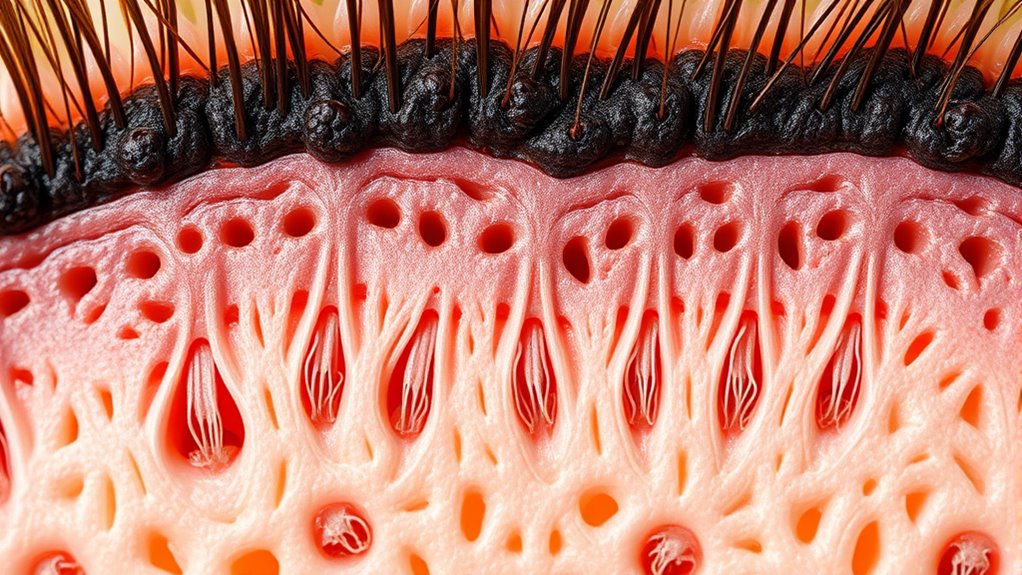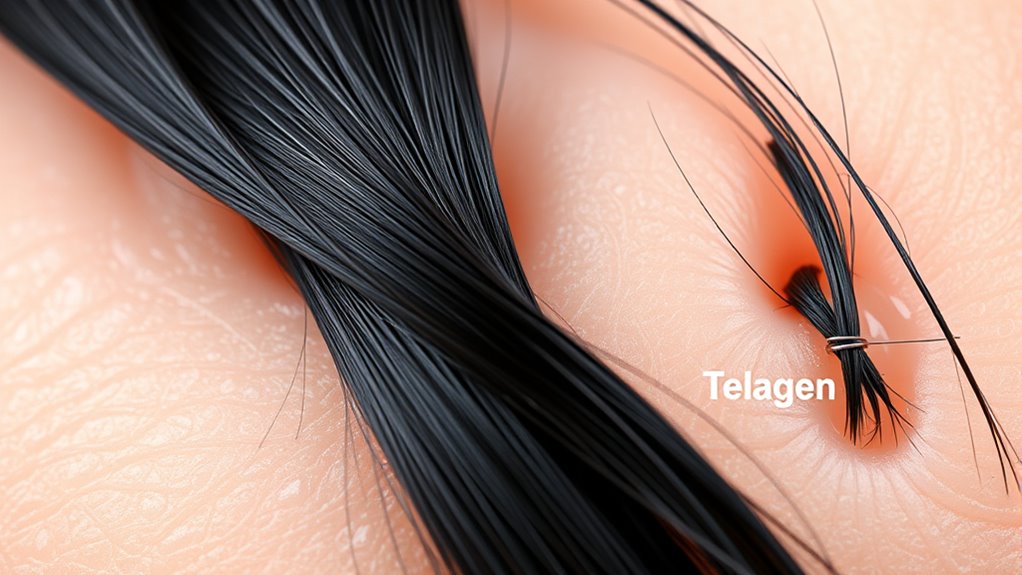The hair growth cycle involves three phases: anagen, where your hair actively grows for years; catagen, a short transition period where the follicle shrinks; and telogen, a resting period lasting a few months before shedding occurs. Understanding these stages helps explain why hair sheds or grows at different times. If you want to learn more about how these phases affect hair health and treatments, keep exploring this fascinating process.
Key Takeaways
- The hair growth cycle comprises three phases: anagen (growth), catagen (transition), and telogen (rest).
- Anagen is the active phase where hair follicles produce new hair, lasting several years.
- Catagen is a brief transitional stage where hair stops growing and follicles shrink.
- Telogen is the resting phase, lasting about three months, before hair naturally sheds.
- The cycle’s balance influences hair density, health, and the effectiveness of hair treatments.

Have you ever wondered why your hair grows at different rates or why some strands fall out more easily? The secret lies in the complex hair growth cycle, which involves three main phases: anagen, catagen, and telogen. Understanding these stages can help you better grasp how your hair renews itself and why certain treatments, like hair transplantation techniques, can be effective. It all begins with the hair follicle, the tiny structure embedded in your scalp that produces hair. Over time, hair follicle aging can influence how well these follicles function, impacting the length and health of your hair. As follicles age, they may become less efficient at producing hair, which can lead to thinning or hair loss. But the good news is that many hair loss treatments aim to stimulate these follicles or replace lost hair through advanced methods.
Understanding the hair growth cycle and follicle aging explains hair thinning and the effectiveness of advanced treatments.
The anagen phase, also known as the growth phase, is when your hair actively grows. During this period, the hair follicle is at its peak activity, producing new cells that form the hair shaft. This period can last several years, and the length of anagen varies from person to person. Healthy, vigorous anagen phases result in longer, thicker hair. Conversely, as you age, the duration of this phase may shorten, contributing to thinning hair. Hair transplantation techniques often target hair follicles in this active growth phase, transplanting healthy follicles from areas where hair is dense to thinning regions, giving the appearance of natural, fuller hair. Additionally, maintaining a healthy scalp environment can promote a longer anagen phase, supporting sustained hair growth.
Following anagen is the catagen phase, a brief transitional stage that lasts a few weeks. During catagen, the hair follicle shrinks, and hair production slows down. The hair detaches from the follicle but remains anchored in place. This process is essential for shedding old hairs and making room for new growth. During this phase, the follicle undergoes a mini-rest, preparing for the next cycle. As you age, some follicles may spend more time in this switch, which can affect overall hair density.
Finally, the telogen phase is the resting stage, lasting around three months. During telogen, hair remains dormant before falling out naturally. Normally, about 10-15% of your scalp hairs are in this phase at any given time. When a large number of hairs enter telogen simultaneously, you notice increased shedding, which can be tied to stress, hormonal changes, or aging. After telogen, the cycle recommences with new hair emerging from the follicle, but if the hair follicle has aged or becomes damaged, it might not restart properly. This is where hair transplantation techniques can help, by relocating healthy follicles that still cycle effectively, restoring hair growth in thinning areas. Recognizing the importance of hair follicle health can be key to understanding and addressing hair loss issues effectively.
Frequently Asked Questions
How Does Age Affect the Hair Growth Cycle?
As you age, your hair cycle variations shift, leading to slower growth and increased age-related hair loss. The anagen phase shortens, meaning hair stays in growth mode for less time, while more hairs enter the telogen phase prematurely. This imbalance results in thinning hair and a noticeable decrease in volume. You might notice your hair becomes finer and less dense as the natural cycle slows down with age.
Can Stress Alter the Phases of Hair Growth?
They say, “Stress is the thief of joy,” but it can also steal your hair’s health. Yes, stress impact can cause hair cycle disruption, pushing more hairs into the telogen (resting) phase prematurely. This results in increased shedding and thinning. Managing stress helps maintain your hair’s natural cycle, preventing unnecessary hair loss. Stay calm, and your hair will thank you for it.
What Foods Promote a Healthy Hair Growth Cycle?
Eating foods rich in dietary nutrients like biotin, zinc, and vitamins A, C, and E supports a healthy hair growth cycle. Incorporate hair supplements if needed to boost nutrient intake. You can promote stronger, shinier hair by including nuts, seeds, leafy greens, and lean proteins in your diet. These nutrients nourish hair follicles, reduce breakage, and encourage ideal hair growth during the anagen phase.
How Do Hormones Influence the Hair Growth Phases?
Like a ship’s captain steering through rough seas, hormones guide your hair’s growth phases. Hormonal fluctuations, caused by stress or endocrine disorders, can disrupt the cycle, leading to shedding or slow growth. When your hormones are balanced, hair remains strong and healthy. Keep an eye on your body’s signals, and consult a specialist if you notice unusual changes, because hormones hold the key to your hair’s essentiality.
Are There Genetic Factors That Determine Cycle Duration?
Yes, your genetic predisposition and hereditary patterns influence your hair cycle duration. These genetic factors can determine how long your hair stays in the anagen (growth) phase and how quickly it shifts to catagen and telogen (resting and shedding) phases. If you have a family history of hair thinning or early hair loss, it’s likely your cycle may be shorter or disrupted, making genetics a key factor in hair growth patterns.
Conclusion
Understanding the hair growth cycle helps you see why hair changes over time. By knowing about the anagen, catagen, and telogen phases, you realize that hair growth is a natural process, not a mystery. Remember, patience is a virtue—you can’t expect overnight results. Keep taking care of your hair, stay consistent, and trust the process. After all, Rome wasn’t built in a day, and healthy hair takes time to flourish.









